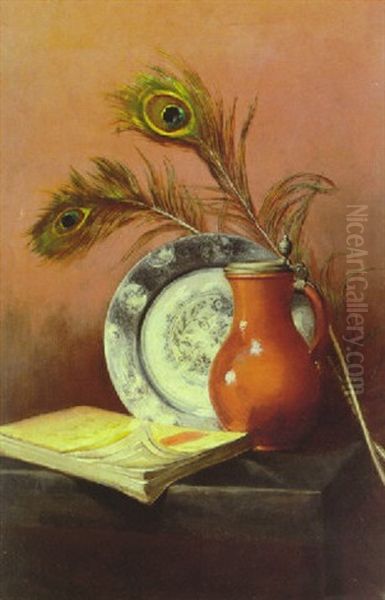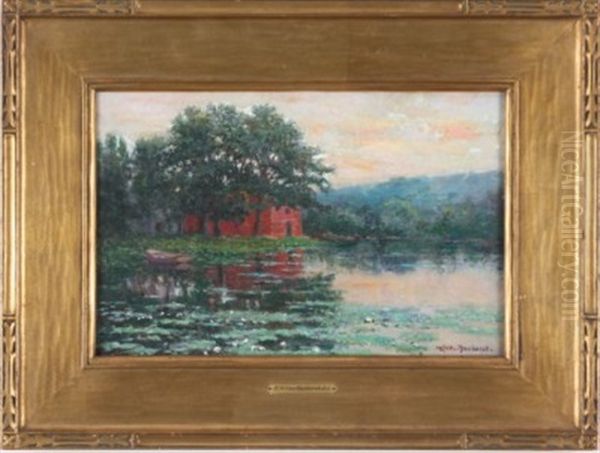Robert Ward Van Boskerck (1855–1932) was a distinguished American painter, primarily celebrated for his evocative landscape paintings that captured the serene beauty of the American East Coast and scenes from his European travels. His work, often imbued with a Tonalist sensibility, reflected a deep appreciation for nature's subtle moods and atmospheric effects. Throughout his career, Van Boskerck was an active participant in the American art scene, associated with prominent artistic institutions and a community of respected peers.
Early Life and Artistic Formation
Born in Hoboken, New Jersey, in 1855, Robert Ward Van Boskerck emerged during a vibrant period of American art. His initial artistic inclinations led him to seek formal training under some of the notable figures in American landscape painting of the era. His tutelage under Alexander Helwig Wyant (1836–1892) was particularly formative. Wyant, a leading American Tonalist painter, was known for his poetic and melancholic landscapes, often depicting the Adirondack Mountains and other wilderness areas with a focus on mood and atmosphere rather than precise topographical detail. This influence likely instilled in Van Boskerck an appreciation for capturing the ephemeral qualities of light and air.
Another significant mentor for Van Boskerck was Robert Swain Gifford (1840–1905). Gifford was a versatile artist, recognized for his landscapes and Orientalist scenes, and was associated with both the Hudson River School's later phase and the burgeoning American Barbizon movement. Gifford's emphasis on direct observation of nature, combined with a romantic sensibility, would have provided Van Boskerck with a strong foundation in landscape composition and technique. The guidance from these masters helped shape Van Boskerck's artistic vision, steering him towards a style that balanced realistic depiction with expressive interpretation.
Artistic Style and Dominant Themes
Van Boskerck's oeuvre is predominantly characterized by landscape painting, though he also ventured into still life. His landscapes often depict tranquil scenes: meandering rivers, quiet woodlands, pastoral countryside, and coastal views. He frequently painted scenes from his native New Jersey, as well as New York State, particularly the Adirondacks, and New England. His European travels also provided subject matter, with works capturing the charm of the English countryside.

His style often aligns with Tonalism, an artistic movement that emerged in the United States in the late 19th century, characterized by soft, diffused light, muted color palettes, and an emphasis on mood and spirituality. Like other Tonalist painters such as George Inness (1825–1894) and Dwight William Tryon (1849–1925), Van Boskerck sought to convey an emotional response to the landscape rather than a mere literal representation. His paintings often feature a harmonious blending of colors, creating a sense of unity and tranquility. He was adept at capturing the subtle nuances of different times of day and seasons, with a particular fondness for the gentle light of early morning or late afternoon.
While landscapes formed the core of his work, Van Boskerck also produced still life compositions. These works, such as Still Life with Ceramic Plate and Peacock Feathers (1907), demonstrate his versatility and skill in rendering texture, form, and light on a smaller, more intimate scale. These still lifes were sometimes created during the winter months or as a diversion from his landscape painting trips, allowing him to explore different compositional challenges and subject matter within the studio environment. His proficiency in oil painting is evident in the delicate brushwork and rich, though often subdued, color palettes that characterize his canvases.
Notable Works and Exhibitions
Several key works highlight Van Boskerck's artistic contributions. Lazy River, believed to have been painted before his death in 1932, exemplifies his ability to capture the serene and idyllic qualities of a gentle waterway. The title itself evokes a sense of peace and timelessness, characteristic of his landscape approach. This painting notably fetched $2,500 at an auction, indicating the market appreciation for his work during and after his lifetime.
A Sussex Cottage Coldthamal, dated to 1900, reflects his travels abroad and his interest in picturesque European scenes. This work was handled by the prominent New York art dealers M. Knoedler & Co., underscoring his connections within the established art market. Similarly, Evening in the Narragansett City, also from 1900 and acquired by Knoedler & Co., likely depicts a coastal scene in Rhode Island, showcasing his ability to render the atmospheric effects of twilight.
His paintings of the American wilderness, such as John Brook, Keene Valley, The Valley at Delhi: New York, and Gill Brook: Adirondacks, demonstrate his engagement with the landscapes that had inspired his teacher, A.H. Wyant, and other American painters like Homer Dodge Martin (1836-1897). John Brook, Keene Valley was notably included in the New Zealand and South Seas International Art Exhibition in Dunedin in 1925, indicating his participation in international art showcases. This exhibition aimed to bring international art to a New Zealand audience and featured works by many American and European artists.

Van Boskerck's work was regularly featured in significant exhibitions. He participated in the Paris Exposition of 1900 (Exposition Universelle), a major international event that showcased achievements in art, science, and industry. American artists like John Singer Sargent (1856–1925), James McNeill Whistler (1834–1903), and Mary Cassatt (1844–1926) also had a strong presence there, and Van Boskerck's inclusion signifies his standing among his contemporaries. He also exhibited at the 33rd Annual Exhibition of Oil Paintings in 1910, where his work was shown alongside that of artists such as Frank Hector Tompkins and Carleton J. Wiggins, the latter known for his Barbizon-style cattle and sheep paintings.
The Sherwood Studio Building: A Hub of Artistic Life
A significant aspect of Van Boskerck's professional life was his association with the Sherwood Studio Building, located at 58 West 57th Street in New York City. This building, a pioneering development in providing combined living and working spaces for artists, became a vibrant hub for the city's artistic community. Van Boskerck maintained a studio there, specifically Room C on the 6th floor.
The Sherwood Studio Building housed a remarkable array of talented individuals. Among his neighbors and colleagues were James Carroll Beckwith (1852–1917), a figure painter and portraitist known for his elegant style influenced by his training in Paris with Carolus-Duran; Edwin Howland Blashfield (1848–1936), a celebrated muralist whose works adorn numerous public buildings, including the Library of Congress; and the marine painter Carleton Chapman. Other artists residing or working in the building during various periods included Willard Allen and Herbert Denman. This environment fostered a sense of camaraderie and intellectual exchange, allowing artists to share ideas, critique each other's work, and stay abreast of current artistic trends. Living and working in such a prominent artistic center undoubtedly contributed to Van Boskerck's development and visibility within the New York art world.
Professional Affiliations and Recognition
Robert Ward Van Boskerck was an active member of several prestigious art organizations, which further cemented his status in the American art community. He was a member of the Society of American Artists, an organization founded in 1877 by a group of younger, European-trained artists, including Augustus Saint-Gaudens (1848–1907) and Wyatt Eaton (1849–1896), who sought a more progressive alternative to the established National Academy of Design. The Society emphasized individual expression and often showcased works influenced by European trends like Impressionism and Symbolism.
Later, Van Boskerck also became a full member (Academician, NA) of the National Academy of Design. Founded in 1825 by artists such as Samuel F.B. Morse and Asher B. Durand, the National Academy was the leading art institution in the United States for much of the 19th century. Election to the Academy was a significant honor, signifying peer recognition of an artist's achievements. His progression to full Academician status indicates the high regard in which he was held by his fellow artists. Other prominent Academicians during his era included figures like William Merritt Chase (1849–1916) and Childe Hassam (1859–1935).
His works were also handled by influential art dealers, most notably M. Knoedler & Co. in New York. Knoedler's was one of the oldest and most respected art galleries in the United States, playing a crucial role in introducing American collectors to both European and American art. Their representation of Van Boskerck's work, including sales records for pieces like A Sussex Cottage Coldthamal and inclusion in their 1906 exhibition catalog, provided him with a vital platform for reaching collectors and the public.
Beyond purely artistic circles, Van Boskerck was also noted in the historical records of the Holland Society of New York, appearing in their rolls around 1885. This suggests an engagement with his cultural heritage, as the Society was dedicated to preserving the history and traditions of the Dutch colonial period in New York.
Later Career, Legacy, and Influence
Robert Ward Van Boskerck continued to paint and exhibit throughout his life, remaining a respected figure in the American art world until his death in 1932. His artistic legacy lies primarily in his sensitive and atmospheric landscape paintings, which contributed to the Tonalist and American Barbizon traditions. While perhaps not as widely known today as some of his more revolutionary contemporaries who embraced modernism, Van Boskerck's work holds an important place in the narrative of late 19th and early 20th-century American art.
His paintings are appreciated for their technical skill, their quiet beauty, and their ability to evoke a specific mood and sense of place. They reflect a period in American art when many painters sought to find a distinctly American voice in landscape painting, one that was informed by European traditions but rooted in the observation of the native environment. His dedication to capturing the nuanced beauty of the American landscape, from the tranquil rivers of New Jersey to the rugged terrain of the Adirondacks, provides a valuable visual record of these regions as they appeared in his time.
His influence can be seen in the continuation of a lyrical and poetic approach to landscape painting. While the art world would soon be swept by more radical movements, the tradition of Tonalist and Barbizon-inspired landscape painting, to which Van Boskerck contributed, maintained an appeal for its introspective and harmonious qualities. Artists like Ralph Albert Blakelock (1847–1919) and Charles Warren Eaton (1857–1937) also worked in similar Tonalist veins, creating moody and atmospheric landscapes that resonated with a public appreciative of nature's more subdued charms.
His works are held in various public and private collections, and their appearance in auctions continues to affirm their enduring appeal. Robert Ward Van Boskerck's career reflects a dedicated artist who skillfully navigated the American art world of his time, contributing a body of work that celebrates the tranquil and enduring beauty of the natural world. He remains a noteworthy figure among the American landscape painters who bridged the 19th-century traditions with the evolving artistic currents of the early 20th century.